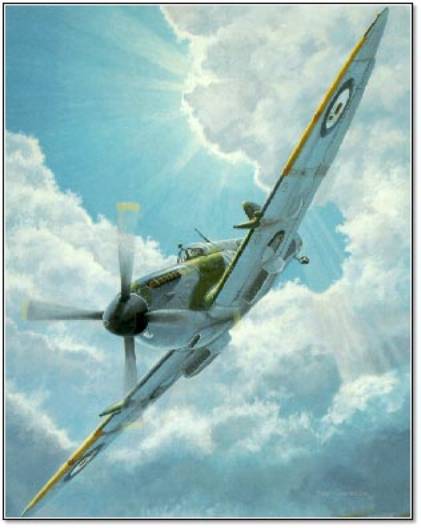|
Russell M. Middleton - High Flight
|
|
| This site originally published in MICHIGAN. | |
|
|
Russell M. Middleton
Click to go Home |
|
Man provides the Soul, the Machine provides the muscle.

"Unpassioned Beauty" by Don Connolly
Click on the image to hear the glorious sound of a Rolls Royce Merlin engine! (25Kb mp3 file)"After the difficult beginnings the ability of the Merlin engine to withstand abuse became a watchword. Few engines tolerate full power loads for any great period, but there are examples on record of Lancaster (bomber powered by four Merlins) pilots losing one of their Merlins shortly after takeoff, but simply continuing the mission with all the remaining throttles pushed to the stops. The engines rarely failed."
Source: http://www.spitfiresociety.demon.co.uk/engines.htm
The Merlin would be in the same league as the Offenhauser (the famous lndy 500 Oval Racing engine in the U.S.A.) and the Formula 1 Cosworth DFV engines, being developmental miles stones in there own right.
Source: http://www.lsr500.com/engines.htm
Born on March 5, 1936, the Supermarine Spitfire, designed by aeronautical engineer Reginald Joseph Mitchell CBE (20 May 1895-11 June 1937) around the Merlin engine, became the finest tactical fighter of its time. Mitchell's design was so good that the Spitfire was the only WW2 fighter aircraft to be in continual production before, during and after the war. On 27 April 1944 during high-speed diving trials at Farnborough to investigate the handling of aircraft near the sound barrier, Spitfire XI EN409, flown by Squadron Leader Martindale, achieved a true airspeed of 606 mph (975 km/h) Mach 0.826, the highest 'Critical Mach number' of any aircraft at that time.High Flight
by Pilot Officer, John Gillespie Magee, Jr.
(1922 - 1941)Oh! I have slipped the surly bonds of earth
And danced the skies on laughter-silvered wings;
Sunward I've climbed, and joined the tumbling mirth
Of sun-split clouds - and done a hundred things
You have not dreamed of - wheeled and soared and swung
High in the sunlit silence. Hov'ring there,
I've chased the shouting wind along, and flung
My eager craft through footless halls of air.
Up, up the long, delirious, burning blue
I've topped the wind-swept heights with easy grace
Where never lark, or even eagle flew -
And, while with silent lifting mind I've trod
The high untrespassed sanctity of space,
Put out my hand and touched the face of God.During the dark days of the Battle of Britain, hundreds of Americans crossed the border into Canada to enlist with the Royal Canadian Air Force. Knowingly breaking the law, but with the tacit approval of the then still officially neutral United States Government, they volunteered to fight Hitler's Germany.
John Gillespie Magee, Jr., was one such American. Born in Shanghai, China, in 1922 to an English mother and a Scotch-Irish-American father, Magee was just 18 years old when he entered flight training. Within the year, he was sent to England and posted to the newly formed No 412 Fighter Squadron, RCAF, which was activated at Digby, England, on 30 June 1941. He was qualified on and flew the Supermarine Spitfire.
Flying fighter sweeps over France and air defense over England against the German Luftwaffe, he rose to the rank of Pilot Officer. At the time, German bombers were crossing the English Channel with great regularity to attack Britain's cities and factories. Although the Battle of Britain was said to be over, the Luftwaffe was still keeping up deadly pressure on British industry and the country.
On September 3, 1941, Magee flew a high altitude (30,000 feet) test flight in a newer model of the Spitfire V. As he orbited and climbed upward, he was struck with the inspiration of a poem -- "To touch the face of God."
Once back on the ground, he wrote a letter to his parents. In it he commented, "I am enclosing a verse I wrote the other day. It started at 30,000 feet, and was finished soon after I landed." On the back of the letter, he jotted down his poem, 'High Flight'.
Just three months later, on December 11, 1941 (and only three days after the US entered the war), Pilot Officer John Gillespie Magee, Jr., was killed. The Spitfire V he was flying, VZ-H, collided with an Oxford Trainer from Cranwell Airfield flown by one Ernest Aubrey. The mid-air happened over Tangmere, England at about 400 feet AGL at 11:30. John was descending in the clouds. At the enquiry a farmer testified that he saw the Spitfire pilot struggle to push back the canopy. The pilot, he said, finally stood up to jump from the plane. John, however, was too close to the ground for his parachute to open. He died instantly. He was 19 years old.
Part of the official letter to his parents read, "Your son's funeral took place at Scopwick Cemetery, near Digby Aerodrome, at 2:30 P.M. on Saturday, 13th December, 1941, the service being conducted by Flight Lieutenant S. K. Belton, the Canadian padre of this Station. He was accorded full Service Honors, the coffin being carried by pilots of his own Squadron."
Inspiration to all?
From: G-GOTO.COM in the London to Sydney Air Race 2001
| Contact Me about this page. | All rights reserved. © Rm² 2003 |